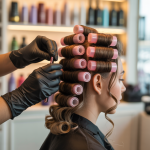Introduction: What is a Hair Perm?
A hair perm, short for “permanent wave,” is a chemical hair treatment that alters the structure of hair to create curls or waves that last for months. By reforming the bonds within the hair shaft, a perm can add volume, movement, and texture, completely transforming your look. Perms are not a new concept—they’ve been popular since the 80s and have evolved significantly over the years. Today, modern perm techniques include various styles tailored to each individual’s hair type and desired aesthetic. While perms are making a resurgence, it’s important to understand how they work, what to expect during and after the process, and what type of upkeep is required. Whether you’re looking for beachy waves or tight ringlets, this ultimate guide provides all the information you need to determine if a perm is the right choice for you.
Types of Hair Perms
There’s no one-size-fits-all perm. The treatment can be customized in curls’ size, shape, and definition to meet various styling needs. The two main types of perms are Hot Perms and Cold Perms. Hot perms use heat to create long-lasting waves with a softer texture, while cold perms rely on chemical solutions without heat for tighter curls. Other styles include spiral perms (tight, corkscrew curls), body wave perms (loose, natural waves), and beach wave perms (effortless, tousled curls). For volume at the roots, a root perm may be ideal. For those seeking subtler styles, volumizing perms are designed to add dimension rather than defined curls. Selecting the right perm depends on factors like your hair length, texture, and your desired outcome. Consulting a stylist ensures you pick the perm type that works best for your hair goals.

The Perming Process: What to Expect
Before getting a perm, a consultation with your stylist is crucial. The stylist evaluates your hair’s health, texture, and length to determine its suitability for perming. The process begins with cleansing the hair to remove any oils and residue that might interfere with the solution. Next, rods or rollers of varying sizes are applied to shape the curls. A chemical solution is then applied, which works by breaking the protein bonds in the hair. After setting for the required time, the hair is rinsed, and a neutralizer is applied to lock in the curls. The process typically takes 2-4 hours, depending on your hair type and the complexity of the style. Afterward, your stylist will advise you on proper aftercare to protect your perm and ensure it lasts as long as possible. Always trust an expert—DIY perms can often lead to uneven results and damage.
Benefits of Permed Hair
Perming offers a wide range of benefits, making it an attractive choice for many people. For starters, a perm provides a long-lasting solution for textured hair, eliminating the need for daily heat styling, which can save time and reduce heat damage. It also offers versatility in styling, as permed hair can be worn loose, styled up, or enhanced with products for various looks. Additionally, perms can create the appearance of thicker, fuller hair, making them a great option for individuals with limp or fine hair. Perms also pair well with haircuts that emphasize movement and volume, such as layered styles. Plus, by reducing the effort needed to maintain curls or waves, perms can simplify your hair routine while giving you the confidence of a no-fuss, polished look. With proper care, a perm is an investment in months of stylish, carefree hair.
Risks and Potential Downsides
While perms have plenty of advantages, they are not without risks or downsides. The process involves chemically altering your hair, which can result in dryness or damage if your hair is not in good condition beforehand. Additionally, the harsh chemicals used in perming treatments may strip moisture from your hair, leaving it brittle if not properly maintained. Another potential downside is that perms are semi-permanent; while they last a few months, you’ll need to grow them out to fully return to your natural hair texture. If you’re someone who likes to switch hairstyles frequently, this lack of flexibility might be a drawback. Furthermore, people with overly processed, bleached, or severely damaged hair may not be good candidates for perming as it could worsen existing damage. It’s essential to weigh these risks and ensure you’re committed to the upkeep before proceeding with a perm.

Perm Aftercare Tips
Proper aftercare is essential for maintaining your perm and protecting the health of your hair. After getting a perm, avoid washing your hair for at least 48 hours, as the curls need time to fully set. When washing, use a sulfate-free shampoo and a hydrating conditioner specifically formulated for curly or permed hair. Minimize heat styling tools like flat irons or curling irons, as these can damage the integrity of your curls. To preserve your perm while sleeping, use a silk bonnet or silk pillowcase to reduce friction and prevent frizz. Regularly apply leave-in conditioners or curl-enhancing products to maintain moisture and curl definition. Deep conditioning treatments once a week can further protect against dryness. Protective hairstyles, such as loose buns or braids, can also help extend the life of your perm. With consistent care, your perm can stay vibrant and beautiful for months.
Who Should Get a Perm?
Perms are suitable for many hair types and people, but not everyone is an ideal candidate. If you have healthy, medium to thick hair, a perm is more likely to result in long-lasting, beautiful curls. People with naturally limp, fine, or straight hair can also benefit by gaining more volume and texture. However, if your hair is heavily bleached, damaged, or has undergone too many chemical treatments, it may not withstand the perming process without risking breakage. Perms are also best for those seeking a long-term style commitment since the process alters the natural structure of your hair. Before deciding, consult a professional stylist, who can assess whether your hair is in good enough condition for a perm and whether the style you want aligns with your hair type. When properly matched, a perm can be a wonderful solution for enhancing your overall look.

DIY Perms vs. Professional Treatment
While DIY perm kits are readily available, professional treatments are recommended for several reasons. Perming hair requires expertise to section, apply chemicals, and time everything precisely to ensure even results. Without proper knowledge, a DIY attempt can result in uneven curls, underprocessed sections, or even hair damage. Professional stylists not only have the training but also access to high-quality products that minimize the harshness of the perming chemicals. They can tailor the treatment to your unique hair type and desired style, whereas at-home kits are one-size-fits-all. While salon perms are more expensive up front, they’re worth the investment when considering the longevity and health of your hair. If you’re determined to attempt a DIY, thoroughly research the process, carefully follow instructions, and perform a strand test to avoid unexpected outcomes.
FAQs About Hair Perms
Q: How long does a perm last?
A: On average, a perm lasts 3-6 months depending on your hair type and aftercare regimen.
Q: Can perms damage your hair?
A: Yes, perms involve chemicals that can dry out or damage your hair if not properly maintained, especially on already weakened hair.
Q: Can you perm-colored or bleached hair?
A: It’s possible but risky. Consult your stylist to assess your hair’s condition before proceeding.
Q: How soon can you wash your hair after a perm?
A: You should wait at least 48 hours to allow the curls to set fully.
Q: Is it possible to undo a perm?
A: While you can’t fully reverse a perm, professional treatments like straightening or keratin therapies can help reduce the curls.
Conclusion
Hair perms offer an exciting opportunity to redefine your look and add lasting texture and volume to your hair. However, they come with risks and require proper consideration to ensure you’re suited for the process. From selecting the right style and type of perm to understanding the process and aftercare, this guide equips you with everything needed for an informed decision. Perms are versatile, stylish, and long-lasting when properly cared for—ideal for those looking for a more manageable and polished hair routine. Consult a professional stylist to explore your options and ensure your hair remains healthy and beautiful throughout the perming journey!









